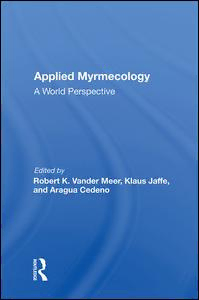
Applied Myrmecology: A World Perspective PDF
Preview Applied Myrmecology: A World Perspective
Applied Myrmecology Westview Studies in Insect Biology Michael D. Breed, Series Editor Applied Myrmecology: A World Perspective, edited by Robert K. Vander Meer, Klaus Jaffe, and Aragua Cedeno The Genetics of Social Evolution, edited by Michael D. Breed and Robert E. Page, Jr. The Entomology of Indigenous and Naturalized Systems in Agriculture, edited by Marvin K. Harris and Charlie E. Rogers Interindividual Behavioral Variability in Social Insects, edited by Robert L. Jeanne Integrated Pest Management on Rangeland: A Shortgrass Prairie Perspective, edited by John L. Capinera Management of Pests and Pesticides: Farmers’ Perceptions and Practices, edited by Joyce Tait and Banpot Napompeth Fire Ants and Leaf-Cutting Ants: Biology and Management, edited by Clifford S. Lofgren and Robert K. Vander Meer Applied Myrmecology A World Perspective EDITED BY Robert K. Yander Meer, Klaus Jaffe, and Aragua Cedeno Routledge Taylor & Francis Group LONDON AND NEW YORK First published 1990 by Westview Press, Inc. Published 2018 by Routledge 52 Vanderbilt Avenue, New York, NY 10017 2 Park Square, Milton Park, Abingdon, Oxon 0X14 4RN Routledge is an imprint of the Taylor & Francis Group, an informa business Copyright © 1990 Taylor & Francis All rights reserved. No part of this book may be reprinted or reproduced or utilised in any form or by any electronic, mechanical, or other means, now known or hereafter invented, including photocopying and recording, or in any information storage or retrieval system, without permission in writing from the publishers. Notice: Product or corporate names may be trademarks or registered trademarks, and are used only for identification and explanation without intent to infringe. Library of Congress Cataloging-in-Publication Data Applied myrmecology : a world perspective / edited by Robert K. Vander Meer, Klaus Jaffe, and Aragua Cedeno. p. cm.—(Westview studies in insect biology) Includes index. ISBN 0-8133-7785-4 1. Ants. I. Vander Meer, Robert K. II, Jaffe, Klaus. III. Cedeno, Aragua. IV. Series. QL568.F7A58 1990 595.79/6—dcl9 89-5666 CIP ISBN 13: 978-0-367-01324-0 (hbk) Contents Foreword, C.S.Lofgren......................................................................................-x Preface...............................................................................................................xiii Acknowledgments..............................................................................................xv ANT PESTS OF THE WORLD 1. Major ant problems of South America H.G. Fowler, J.V.E. Bernard i, J.C. Delabie, L.C. Forti and V. Pereira-da-Silva............................................3 2. Pest ants of India G.K. Veeresh.................................................................................15 3. Pest ants in urban and agricultural areas of southern Africa A.J. Prins, H.G. Robertson and A.P rins....................................25 4. Seed harvesting ant pests in Australia A.N. Andersen..............................................................................34 5. Pest ants in the Hawaiian islands N. Reimer, J.W. Beardsley and G. John.................................40 6. Ants that have pest status in the United States C.R. Thompson............................................................................51 SYSTEMATICS AND MORPHOLOGY Overview J.E. Lattke...................................................................................-71 7. Chemotaxonomy applied to fire ant systematics in the United States and South America R.K. Vander Meer and C.S. Lofgren........................................75 8. A survey of the glandular system of fire ants J. Billen......................................................... .85 9. A comparison of venom and hydrocarbon profiles from alates in Texas monogyne and polygyne fire ants, Solenopsis invicta L. Greenberg, H.J. Williams and S.B. Vinson..........................95 VI 10. Cephalic exocrine glands of ants: a morphological view C. da Cruz-Landim...................................................................102 11. Morphology of the digestive tract and associated excretory organs of ants F. H. Caetano..........................................................................119 REPRODUCTION Overview L. Passera...................................................................................133 12. Reproductive strategies of the fire ant A.P. Bhatkar...............................................................................138 13. Oviposition and growth of the fire ant Solenopsis invicta D. F. Williams.........................................................................150 14. Social control of reproduction in fire ant colonies E. L. Vargo..............................................................................158 15. Egg-laying in Atta sexdens rubropilosa, under laboratory conditions T.M.C. Della Lucia, E.F. Vilela, D.D.O. Moreira, J.M.S. Bento and N. Dos Anjos................................................173 16. Foundress female weight and cooperative foundation in Atta leaf-cutting ants A. Mintzer..................................................................................180 NATURAL HISTORY AND BIOLOGY Overview S.D. Porter.................................................................................187 17. Evolution of ant communities in response to invasion by the fire ant Solenopsis invicta G. R. Camilo and S.A. Phillips, Jr............................................190 18. Community structure and Solenopsis invicta in Sao Paulo H. G. Fowler, J.V.E. Bernardi and L.F.T. di Romagnano............................................................................199 19. A decade-long study of an Attine ant colony B. A. Weiss...............................................................................208 20. Development of the ant-fungus relationship in Atta laevigata A. Cedeno and M.J. Leon...........................................................211 21. Methods for estimating the population density of leaf-cutting ant colonies S. Claver....................................................................................220 22. Methods for the evaluation of leaf-cutting ant harvest H.G. Fowler, L.C. Ford and L.F.T. di Romagnano.................228 23. Seasonal activity of Atta insularis, an important citrus pest in Jaguey Grande, Cuba L.F. Perez Per era, A. Gonzalez and J.F. Martinez...............242 vii 24. Relative protection of Cecropia trees against leaf-cutting ants in tropical America P. Jolivet.............................................................................. 251 25. Invertebrate enemies and nest associates of the leaf-cutting ant Atta texana (Buckley) (Formicidae, Attini) D.A. Waller and J.C. Moser............................................... 255 26. Biology of carpenter ants L.D. Hansen and R.D. Akre............................................... 274 27. The little fire ant Wasmannia auropmctata (R.) (Hymenoptera: Formicidae) P. Ulloa-Chacon and D. Cherix........................................ .281 28. Biological aspects of the "hormiga loca," Paratrechina (Nylanderia) fulva (Mayr), in Colombia I. Zenner-Polania............................................................. .290 29. Ant pests of the Tapinomini tribe A.Y. Harada........................................................................ .298 BEHAVIORAL AND CHEMICAL ECOLOGY Overview E.D. Morgan.......................................................................... 319 30. Nestmate recognition in fire ants: monogyne and polygyne populations R.K. Vander Meer, M.S. Obin and L. Morel...................... 322 31. Behavioral interactions of fire ants and their parasites, predators and inquilines D.P. Wojcik.......................................................................... 329 32. Territorial ecology of the leaf-cutting ant, Atta laevigata A. Salzemann and K. Jaffe................................................. .345 33. Foraging strategies and vegetation exploitation in the leaf-cutting ant Atta cephalotes (L.)-- a preliminary simulation model J. Reed and J.M. Cherrett................................................. .355 34. Senses used by Acromyrmex subterraneus molestans during homing orientation, under laboratory conditions M.S. Guajara, E.F. Vilela and K. Jaffe............................ .367 35. The discovery of new resources and subsequent trail formation by Acromyrmex octospinosus in Guadeloupe P. Therrien and J.N. McNeil.............................................. .373 36. Factors controlling foraging patterns in the leaf-cutting ant Acromyrmex octospinosus (Reich) J.J. Knapp, P.E. Howse and A. Kermarrec....................... .382 37. Foraging and fungal substrate selection by leaf-cutting ants H.L. Vasconcelos and H.G. Fowler.................................... .410 38. Toxic effect of plants on leaf-cutting ants and their symbiotic fungus O.C. Bueno, M.J.A. Hebling-Beraldo, O. Aulino da Silva, F. Pagnocca, J.B. Fernandez and P.C. Vieira.................................................................... 420
